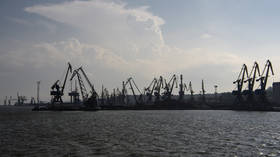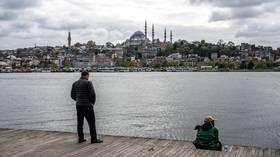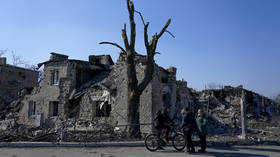Safe passage opens through Azov Sea – Russia

A safe route for ships has been established through the Sea of Azov, according to the Russian military. The passage was opened after Moscow reported sweeping sea mines from the area and making the port of Mariupol safe for operation.
The passage from the Azov Sea to the Black Sea is 115 miles long and two miles wide, according to the military’s statements. First opened on Wednesday, it is available for traffic every day between 8:00 am and 7:00 pm local time, according to the Russian defense ministry.
A separate 80-mile-long, three-mile-wide naval corridor in the Black Sea has been maintained by the Russian Navy for some time and remains open for traffic.
Moscow blames Ukraine for making the two seas it shares with Russia unsafe for civilian ships. Kiev ordered the deployment of sea mines near its shores to ward off possible amphibious assaults by Russia.
The mines are of a relatively old design and may detach from their anchors during storms and float freely, posing a threat to shipping. At least one reportedly drifted towards Turkey in late March and was destroyed to protect traffic through the Bosphorus.
On Tuesday, the Russian military reported that it had completed making the port of Mariupol and the waters near it safe. Minesweepers and demolition experts secured 1.5 million square meters of the sea, 50km of the shoreline, port structures and 32 ships that were docked in the port. A total of 12,000 explosives were found and disabled, the report said. The military also floated and removed a Ukrainian patrol boat that was sunk by Ukrainian troops to obstruct the waterway to Mariupol, the Defense Ministry said.
Mariupol was one of Ukraine’s busiest ports before the Russian attack against the country. It is located on the northeastern shore of the Azov Sea and is claimed by the Donetsk People’s Republic as part of its territory.
The city came under full control of Russian forces earlier this month, after Ukrainian troops that took cover in the Azovstal steelworks surrendered. The plant has its own shore facilities and is located about 6km from the main city port, so while Ukrainian forces were present, the waters near Mariupol were not completely safe.
Russia attacked the neighboring state in late February, following Ukraine’s failure to implement the terms of the Minsk agreements, first signed in 2014, and Moscow’s eventual recognition of the Donbass republics of Donetsk and Lugansk. The German- and French-brokered protocols were designed to give the breakaway regions special status within the Ukrainian state.
The Kremlin has since demanded that Ukraine officially declare itself a neutral country that will never join the US-led NATO military bloc. Kiev insists the Russian offensive was completely unprovoked and has denied claims it was planning to retake the two republics














